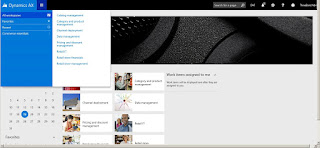Hello All,
Recently we faced an issue while implementing AX 7 for one of our customer. The issue was with the menu Items displayed on the left hand side of the browser. We simply couldn't see the menu even though we logged in using the System administrator account. All it displayed was few menu's hiding the rest. Please refer to the image below for more clarity.
Logged in using the system administrator account
After doing lot of re-search we figured out that the issue is caused because Commerce essentials configuration in the license configuration for AX 7 was enabled due to this the system will only enable basic functionalities related to Retail and hence the menu was not being displayed.
Then the next issue was that we were not able to navigate to Licence configuration page to disable the Commerce essentials configuration since the menu was not displayed. The workaround to access the page is to add the following piece of string highlighted in bold after the main url.
https://devaos.cloudax.dynamics.com/?cmp=DAT&mi=SysConfiguration
This will take you to License configuration page and then in the license configuration page disable the Commerce essentials key, logout and Log in again. Now everything should be fine. You will again see the menus in AX :)
Happy Daxing :).Watch out for my next post




